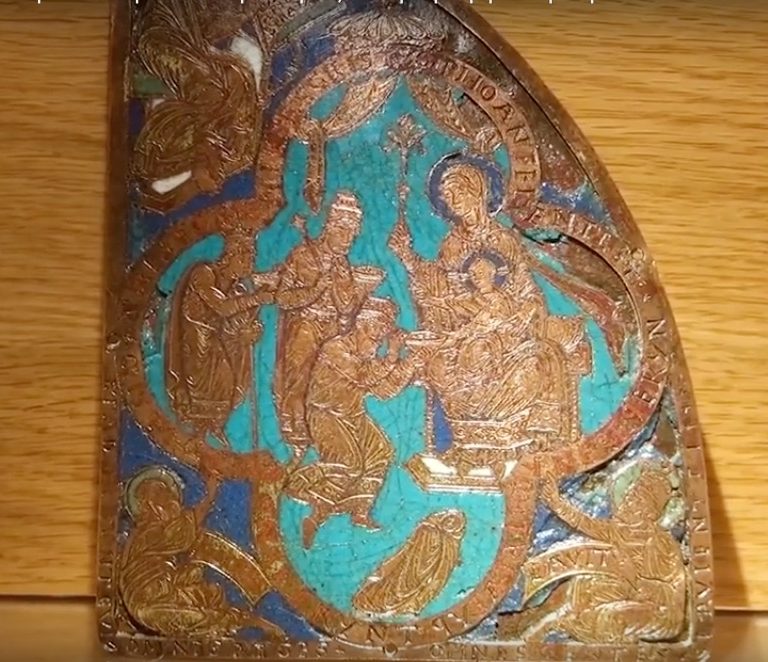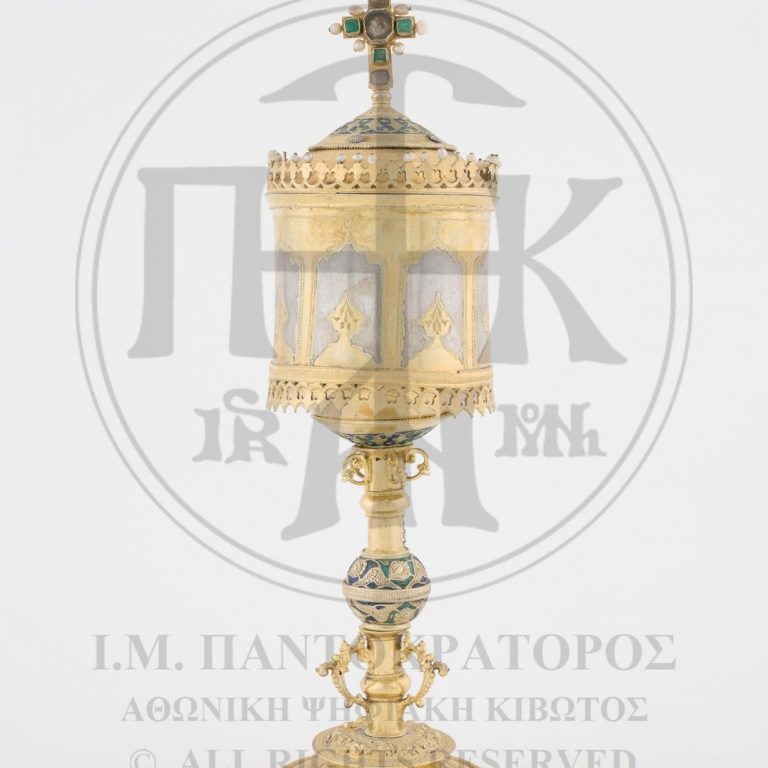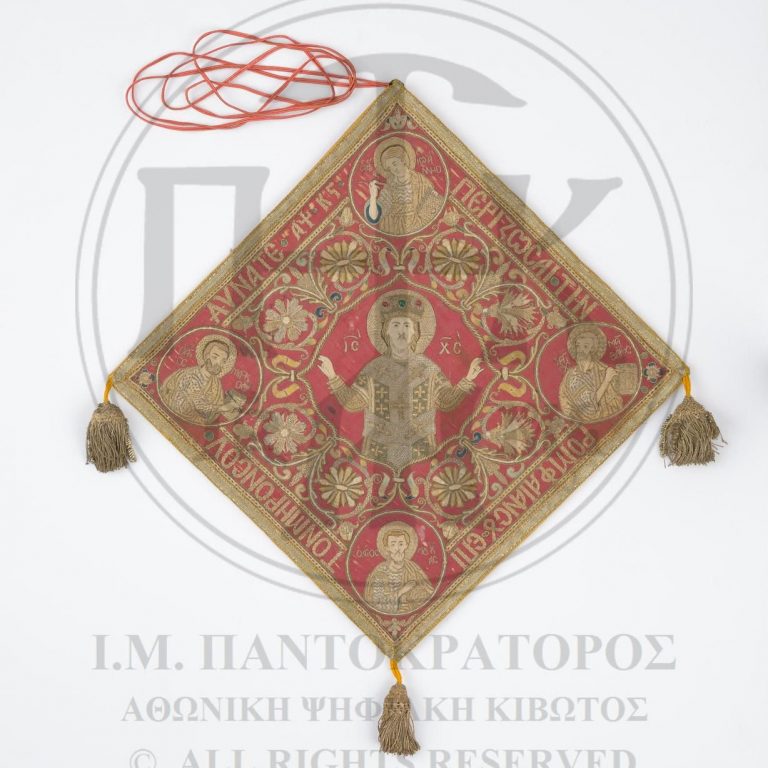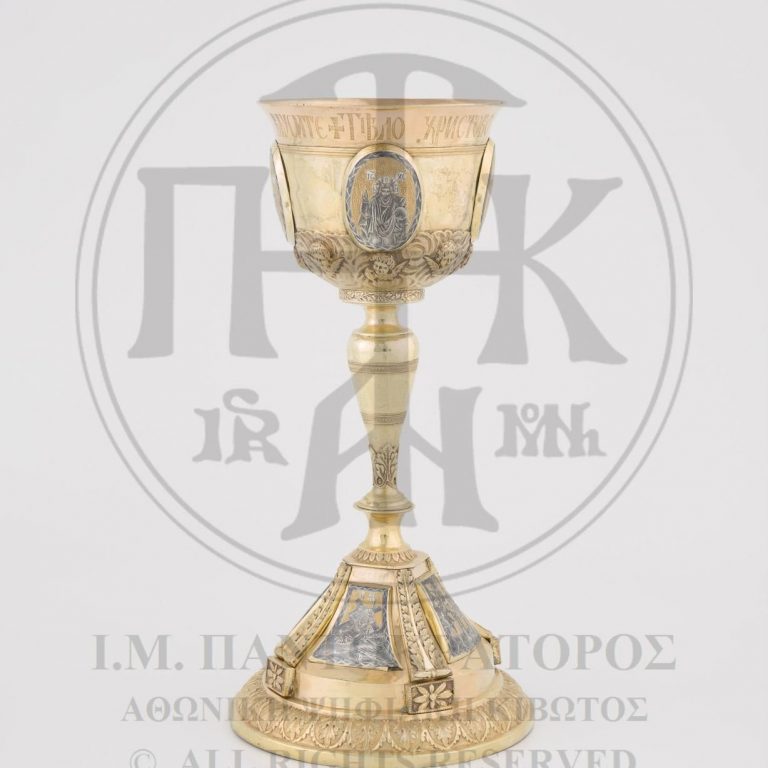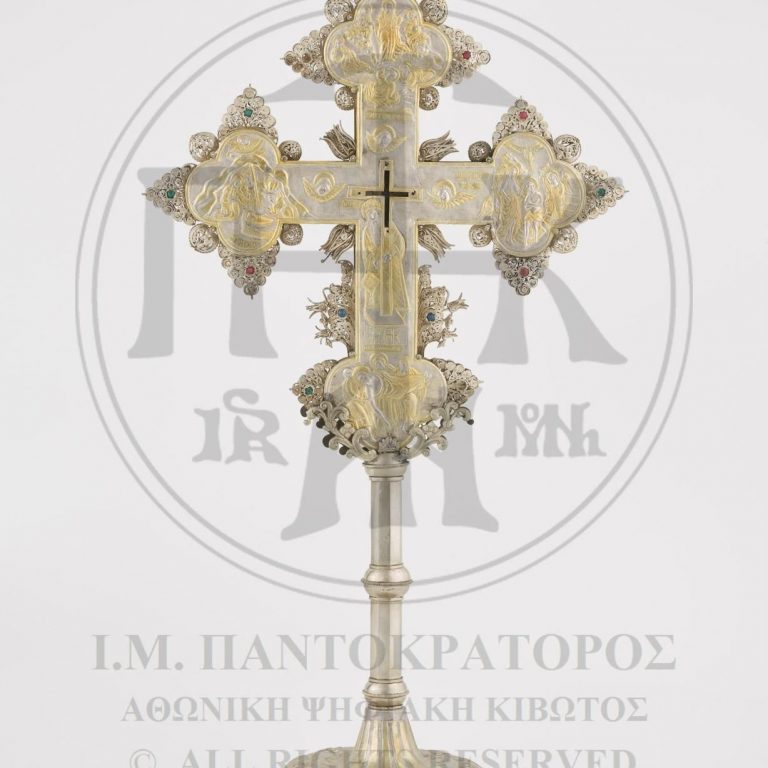Embroidered/Metal/Ceramic
One of the most important artifacts is the Byzantine Επιτάφιος (Epitafios), the sacred liturgical 'tapestry' depicting the entombment of Christ. This artefact was donated by the founders of the Monastery, and is an exceptional example of goldwork, i.e, embroidery using gold or metal threads; it has survived in very good condition. The lifeless body of Christ is depicted on a background with crosses of many shapes, while at the four corners, an equal number of angels are holding coronets.
From the 16th century comes the goldworked ωμοφόριο (omoforio, a liturgical vestment worn around the shoulders) of the Patriarch Jeremiah of Tranos, and other sacred vestments with goldwork. The omoforio has a goldworked commemoratory inscription, and is decorated with representations of the twelve apostles and the hierarchs. (The donor, Patriarch Jeremiah, had helped the Monastery in a number of different ways.)
The 17th century is represented by an επιτραχήλιο (epitrachilio, a liturgical vestment worn around the neck) embroidered with multiple scenes from the life of Christ, while a number of vestments and embroidered articles are dated to the 18th and 19th centuries. Among the latter, a goldwork-on-velvet heirarchial σάκκος (saccos, an open-sided, full-length vestment which covers the body, worn only by heirarchs), an επιγονάτιο (epigonatio, a rombos-shaped scapular worn around the neck and reaching to the knees) from 1726 depicting Christ and the evangelists, and two embroidered icons of St. Charalambos and the evangelist Markos, which belonged to the Sacrist Cyrillos.
A special place is likewise held by the small surviving piece of the copper shield of St Merkourios, which was decorated with enamel and depicts the veneration of infant Christ by the Magi and prophets, likely from a workshop in Holland or Germany in the 13th or 14th century.
As for the the metal- and silver-worked artifacts (such as sacred vessels, crosses, buckles, etc.), some date to the 17th century, while the majority are from the 18th and 19th centuries. The oldest-dated vessel is a goldplated, silver and enamel αρτοφόριο (artoforio, monstrance) from 1621, a work of the goldsmith Fotios and the property of the priest Constantinos. A silver two-leaf New Testament cover dates to 1777. The two leaves are decorated with representations of the twelve apostles and other personages, as well as a cross. The elaborate images are sculpted from metal and rhinoceros horn, making the artefact an example of exceptionally skilful micro-sculpting. The book cover was dedicated by the well known Sacristan Cyrillos, who was very active in the Monastery during that period.
Several artefacts date to 1788: (a) A large, filigree cross which protects a relic of the True Cross, dedicated by the Prior Benjamin of Lesbos, and made by the goldsmith Panagos. (b) Other filigree sanctification crosses, and a filigree censer. (c) a hierarchical sceptre and a buckle of Zacharias Maridakis, the Metropolite of Crete, who is portrayed in a portable icon which had been dedicated to the Monastery in 1780.
The Monastery also has a large number of vessels which come from 19th century Russian silver and gold workshops, most likely due to the efforts of the Pantokratoros monks in Russia. Especially notable is a chalice from 1818 from Moscow, which is decorated with scenes __________, a New Testament of 1810-1819 which has a relief depicting the Dormition of the Virgin Mary, and two amulets of high-quality enamel.
An exceedingly rare piece is a 16th century glazed ceramic holy water vial used in rituals, which was made in an workshop in Nicea, and which is decorated with beautiful floral and faunal images. Last but not least is an iron chest with a painted exterior and a carved interior, which was made under the supervision of the Prior Leontios in 1737 as a storage chest for the sacred relics of the Monastery. It was made by Greek craftsmen in Adrianoupolis, and is an excellent example of this type of item.
From the 16th century comes the goldworked ωμοφόριο (omoforio, a liturgical vestment worn around the shoulders) of the Patriarch Jeremiah of Tranos, and other sacred vestments with goldwork. The omoforio has a goldworked commemoratory inscription, and is decorated with representations of the twelve apostles and the hierarchs. (The donor, Patriarch Jeremiah, had helped the Monastery in a number of different ways.)
The 17th century is represented by an επιτραχήλιο (epitrachilio, a liturgical vestment worn around the neck) embroidered with multiple scenes from the life of Christ, while a number of vestments and embroidered articles are dated to the 18th and 19th centuries. Among the latter, a goldwork-on-velvet heirarchial σάκκος (saccos, an open-sided, full-length vestment which covers the body, worn only by heirarchs), an επιγονάτιο (epigonatio, a rombos-shaped scapular worn around the neck and reaching to the knees) from 1726 depicting Christ and the evangelists, and two embroidered icons of St. Charalambos and the evangelist Markos, which belonged to the Sacrist Cyrillos.
A special place is likewise held by the small surviving piece of the copper shield of St Merkourios, which was decorated with enamel and depicts the veneration of infant Christ by the Magi and prophets, likely from a workshop in Holland or Germany in the 13th or 14th century.
As for the the metal- and silver-worked artifacts (such as sacred vessels, crosses, buckles, etc.), some date to the 17th century, while the majority are from the 18th and 19th centuries. The oldest-dated vessel is a goldplated, silver and enamel αρτοφόριο (artoforio, monstrance) from 1621, a work of the goldsmith Fotios and the property of the priest Constantinos. A silver two-leaf New Testament cover dates to 1777. The two leaves are decorated with representations of the twelve apostles and other personages, as well as a cross. The elaborate images are sculpted from metal and rhinoceros horn, making the artefact an example of exceptionally skilful micro-sculpting. The book cover was dedicated by the well known Sacristan Cyrillos, who was very active in the Monastery during that period.
Several artefacts date to 1788: (a) A large, filigree cross which protects a relic of the True Cross, dedicated by the Prior Benjamin of Lesbos, and made by the goldsmith Panagos. (b) Other filigree sanctification crosses, and a filigree censer. (c) a hierarchical sceptre and a buckle of Zacharias Maridakis, the Metropolite of Crete, who is portrayed in a portable icon which had been dedicated to the Monastery in 1780.
The Monastery also has a large number of vessels which come from 19th century Russian silver and gold workshops, most likely due to the efforts of the Pantokratoros monks in Russia. Especially notable is a chalice from 1818 from Moscow, which is decorated with scenes __________, a New Testament of 1810-1819 which has a relief depicting the Dormition of the Virgin Mary, and two amulets of high-quality enamel.
An exceedingly rare piece is a 16th century glazed ceramic holy water vial used in rituals, which was made in an workshop in Nicea, and which is decorated with beautiful floral and faunal images. Last but not least is an iron chest with a painted exterior and a carved interior, which was made under the supervision of the Prior Leontios in 1737 as a storage chest for the sacred relics of the Monastery. It was made by Greek craftsmen in Adrianoupolis, and is an excellent example of this type of item.

